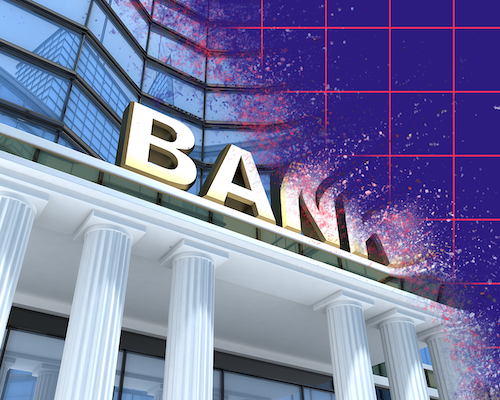Since the launch of Bitcoin, blockchain technology has been a greatly admired addition to the tech space. The technology provides a trustless backbone to the decentralized nature of cryptocurrencies, while also being universal and versatile enough to be implemented into industries beyond that. We’ve covered blockchain in retail and blockchain in food and agriculture, now it’s time to look at blockchain in banking.
What Are The Benefits Of Blockchain Technology
Blockchain technology is designed to be a decentralized storage of data. The technology is run and operated by a network of nodes located anywhere around the world, instead of one central server housing everything. These nodes are each responsible for updating and sharing updates of the entire blockchain network, and store these public ledgers individually.
Once a transaction takes place on a specific blockchain, the information is verified by a miner and then stored in a block. Each block contains its own special code and the code of the one before it to ensure that it is stored in chronological order, and entirely immutable. The updated version of the blockchain is then shared with the network. This makes the entire blockchain network incredibly reliable, and able to operate without the need for a third party.
The first version of blockchain was designed in 1991 and used to timestamp and store office files. Over the years it evolved and when Satoshi Nakamoto released it in 2009 it had taken on a life of its own. The technology now allows for transactions to take place, smart contract functionality and acts as a global public ledger of the entire transactional history of the network. While it was initially introduced as a facilitator of cryptocurrency, its use cases stretch far beyond that.
Blockchain In Banking
There are a number of key factors that blockchain technology can contribute to the banking world. Firstly, the network can offer faster transactions as the funds do not need to pass through several banks or financial institutions. The technology also offers lower transaction fees, again because of the more direct line of payment. With its decentralized nature, there are no geographical limitations, allowing anyone anywhere to send funds to anyone, anywhere. And lastly, blockchain is exempt of any government interference. Transactions are completed as and when instructed, with no need for third party authentication.
5 Banks Embracing Blockchain Technology
In the US, JP Morgan created a blockchain based project that focuses on the cross-border payments for the Interbank Information Network (IIN). The project is in partnership with the Royal Bank of Canada and Australian ANZ. The technology will be used for both the legal compliance aspect and the calculation process of cross-border payments. The INN network already has 220 banks on board, while a further 75 are testing it.
A German bank started testing smart contract functionality in a blockchain network to facilitate trade financing for manufacturers. Commerzbank provided financing on the Marco Polo platform for the pump and valve manufacturer KSB SE and a technology company Voith. The two companies outlined the supply chain process, and conditional payment was provided. Through each stage (from shipping to delivery) the information was added to the blockchain in real time and reconciliation was automatically carried out. The process presented a streamlined approach to large business dealings, cutting out labour and communication while still maintaining the security and integrity.
Over in Switzerland, UBS bank is testing the Ethereum network to automate the regulatory requirements of the EU directive exchange operations (MiFID II / MiFIR). The technology will allow banks to anonymously exchange Legal Entity Identifier data, verify the data, and implement new rules more timeously.
The same bank also launched a start up crypto bank, SEBA Crypto AG, in 2018 to offer crypto companies traditional banking services. The platform offers everything from custody services, crypto trading, to asset management. The $100 million project also plans on opening brick-and-mortar banks in the future.
In Spain, Banco Santander launched a blockchain service that makes use of Ripple’s xCurrent technology for cross border payments. The Santander One Pay FX service facilitates users in Spain paying pounds to the UK and dollars to the US, allows UK residents to send Euros to twenty one European countries, and offers services to Poland and several other European countries. Ten months after launching, the bank signed a $700 million deal with IMB to make use of their blockchain, big data and AI technologies.
In 2019, the Dutch bank ING’s blockchain department started testing the technology to assist banks in enhancing compliance with the European General Data Protection Regulation (GDPR) and privacy protection of customers. Their research at this stage is still largely academic as they explore different alternatives to implementing this privacy technology.
Banking On Blockchain
Clearly there is still a far way to go for the true implementation of blockchain in banking, but the first fires have been lit. As the research and data piles up, it seems only natural that blockchain will be implemented in more financial institutions to streamline the services they offer. With payment giants Visa and Mastercard already looking into the technology, anything could happen in the next 5 years.
_______________________________________________________
Oobit Technologies Pte, 50 Raffles Place #37-00 Singapore Land Tower, Singapore (048623). is a company registered in Singapore (no:201716443G), that has been approved as Appointed Representative of Oobit Technologies OÜ, Harju maakond, Tallinn, Lasnamäe linnaosa, Väike-Paala tn 2, 11415, (no: 14852617 ). Which is authorized and regulated by the FIU (no: FVR001421 and FRK001304).

